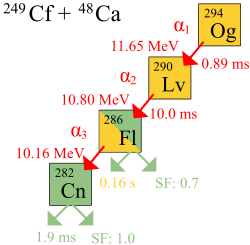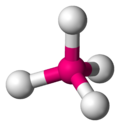Oganesson
Oganesson is a synthetic chemical element with symbol Og and atomic number 118. Oganesson has the highest atomic number and highest atomic mass of all known elements. The radioactive oganesson atom is very unstable, and since 2005, only five (possibly six) atoms of the isotope Oganesson-294 have been created.
History
The element is named in honor of Yuri Oganessian. It was first created in 2002 at the Joint Institute for Nuclear Research (JINR) in Dubna, Russia by a joint team of Russian and American scientists. In December 2015, it was recognized as one of four new elements by the Joint Working Party of the international scientific people at IUPAC and IUPAP. It was formally named on 28 November 2016.[1] It had a previous name given by the IUPAC called "Ununoctium" meaning "one-one-eight" in Latin. This was a placeholder name until the element was discovered and a name was given. The possibility of a seventh noble gas, after helium, neon, argon, krypton, xenon, and radon, was considered almost as soon as the noble gas group was discovered. Danish chemist Hans Peter Jørgen Julius Thomsen predicted in April 1895, the year after the discovery of argon, that there was a whole group of chemically unreactive gases similar to argon that would link the halogen and alkali metal groups. He expected that the seventh of this series would end a 32-element period which contained elements like thorium and uranium and have an atomic weight of 292, close to the 294 now known for the first and only confirmed isotope of oganesson.
Chemistry
The chemistry of Oganesson cannot be found because of how radioactive it is and how short its half-life is, which is only 0.69 milliseconds. However, predictions can be made based on properties the group has in common with each other. Since it's a noble gas, it is predicted that it will be a diatomic molecule (it only pairs with itself).
Uses
| General properties | ||||||||||||||||||
|---|---|---|---|---|---|---|---|---|---|---|---|---|---|---|---|---|---|---|
| Pronunciation | ||||||||||||||||||
| Mass number | 294 (most stable isotope) (unconfirmed: 295) | |||||||||||||||||
| Oganesson in the periodic table | ||||||||||||||||||
| ||||||||||||||||||
| Atomic number (Z) | 118 | |||||||||||||||||
| Group | group 18 | |||||||||||||||||
| Period | period 7 | |||||||||||||||||
| Block | p-block | |||||||||||||||||
| Element category | noble gas (predicted) | |||||||||||||||||
| Electron configuration | [Rn] 5f14 6d10 7s2 7p6 (predicted)[3][4] | |||||||||||||||||
Electrons per shell | 2, 8, 18, 32, 32, 18, 8 (predicted) | |||||||||||||||||
| Physical properties | ||||||||||||||||||
| Phase at STP | Og: Unknown phase (predicted)[3] | |||||||||||||||||
| Boiling point | 350±30 K (80±30 °C, 170±50 °F) (extrapolated)[3] | |||||||||||||||||
| Density when liquid (at m.p.) | 4.9–5.1 g/cm3 (predicted)[5] | |||||||||||||||||
| Critical point | 439 K, 6.8 MPa (extrapolated)[6] | |||||||||||||||||
| Heat of fusion | 23.5 kJ/mol (extrapolated)[6] | |||||||||||||||||
| Heat of vaporization | 19.4 kJ/mol (extrapolated)[6] | |||||||||||||||||
| Atomic properties | ||||||||||||||||||
| Oxidation states | (−1),[4] (0), (+1),[7] (+2),[8] (+4),[8] (+6)[4] (predicted) | |||||||||||||||||
| Ionization energies | ||||||||||||||||||
| Covalent radius | 157 pm (predicted)[11] | |||||||||||||||||
| Other properties | ||||||||||||||||||
| Natural occurrence | Og: Synthetic | |||||||||||||||||
| Crystal structure | face-centered cubic (fcc) (extrapolated)[12] | |||||||||||||||||
| CAS Number | 54144-19-3 | |||||||||||||||||
| History | ||||||||||||||||||
| Naming | after Yuri Oganessian | |||||||||||||||||
| Prediction | Niels Bohr (1922) | |||||||||||||||||
| Discovery | Joint Institute for Nuclear Research and Lawrence Livermore National Laboratory (2002) | |||||||||||||||||
| Main isotopes of oganesson | ||||||||||||||||||
| ||||||||||||||||||
It currently has no uses due to how radioactive and how short its half-life is.
Oganesson Media
Radioactive decay pathway of the isotope oganesson-294. The decay energy and average half-life are given for the parent isotope and each daughter isotope. The fraction of atoms undergoing spontaneous fission (SF) is given in green.
Oganesson (row 118) is slightly above the "Island of stability" (white ellipse) and thus its nuclei are slightly more stable than otherwise predicted.
XeF4 has a square planar molecular geometry.
Other websites
| Wikimedia Commons has media related to Lua error in Module:Commons_link at line 62: attempt to index field 'wikibase' (a nil value).. |
- WebElements.com - Oganesson
- Oganesson at The Periodic Table of Videos (University of Nottingham)
References
- ↑ Staff (30 November 2016). "IUPAC Announces the Names of the Elements 113, 115, 117, and 118". IUPAC. https://iupac.org/iupac-announces-the-names-of-the-elements-113-115-117-and-118/. Retrieved 1 December 2016.
- ↑ Ritter, Malcolm (9 June 2016). Periodic table elements named for Moscow, Japan, Tennessee. Associated Press. https://apnews.com/bd44f5cccba04d4fbaec96273e06fb45/names-chemical-elements-honor-moscow-japan-tennessee. Retrieved 19 December 2017.
- ↑ 3.0 3.1 3.2 3.3 Nash, Clinton S. (2005). "Atomic and Molecular Properties of Elements 112, 114, and 118". Journal of Physical Chemistry A. 109 (15): 3493–3500. Bibcode:2005JPCA..109.3493N. doi:10.1021/jp050736o. PMID 16833687.
- ↑ 4.0 4.1 4.2 4.3 Hoffman, Darleane C.; Lee, Diana M.; Pershina, Valeria (2006). "Transactinides and the future elements". In Morss; Edelstein, Norman M.; Fuger, Jean (eds.). The Chemistry of the Actinide and Transactinide Elements (3rd ed.). Dordrecht, The Netherlands: Springer Science+Business Media. ISBN 1-4020-3555-1.
- ↑ Bonchev, Danail; Kamenska, Verginia (1981). "Predicting the Properties of the 113–120 Transactinide Elements". Journal of Physical Chemistry. American Chemical Society. 85 (9): 1177–1186. doi:10.1021/j150609a021.
- ↑ 6.0 6.1 6.2 Eichler, R.; Eichler, B., Thermochemical Properties of the Elements Rn, 112, 114, and 118 (PDF), Paul Scherrer Institut, retrieved 2010-10-23
- ↑ Han, Young-Kyu; Bae, Cheolbeom; Son, Sang-Kil; Lee, Yoon Sup (2000). "Spin–orbit effects on the transactinide p-block element monohydrides MH (M=element 113–118)". Journal of Chemical Physics. 112 (6): 2684. Bibcode:2000JChPh.112.2684H. doi:10.1063/1.480842.
- ↑ 8.0 8.1 Kaldor, Uzi; Wilson, Stephen (2003). Theoretical Chemistry and Physics of Heavy and Superheavy Elements. Springer. p. 105. ISBN 140201371X. Retrieved 2008-01-18.
- ↑ Pershina, Valeria. "Theoretical Chemistry of the Heaviest Elements". In Schädel, Matthias; Shaughnessy, Dawn (eds.). The Chemistry of Superheavy Elements (2nd ed.). Springer Science & Business Media. p. 154. ISBN 9783642374661.
- ↑ Fricke, Burkhard (1975). "Superheavy elements: a prediction of their chemical and physical properties". Recent Impact of Physics on Inorganic Chemistry. 21: 89–144. doi:10.1007/BFb0116498. Retrieved 4 October 2013.
- ↑ Chemical Data. Ununoctium - Uuo, Royal Chemical Society
- ↑ Grosse, A. V. (1965). "Some physical and chemical properties of element 118 (Eka-Em) and element 86 (Em)". Journal of Inorganic and Nuclear Chemistry. Elsevier Science Ltd. 27 (3): 509–19. doi:10.1016/0022-1902(65)80255-X.
- ↑ Oganessian, Yu. Ts.; Utyonkov, V. K.; Lobanov, Yu. V.; Abdullin, F. Sh.; Polyakov, A. N.; Sagaidak, R. N.; Shirokovsky, I. V.; Tsyganov, Yu. S.; Voinov, A. A.; Gulbekian, G. G.; Bogomolov, S. L.; Gikal, B. N.; Mezentsev, A. N.; Iliev, S.; Subbotin, V. G.; Sukhov, A. M.; Subotic, K.; Zagrebaev, V. I.; Vostokin, G. K.; Itkis, M. G.; Moody, K. J.; Patin, J. B.; Shaughnessy, D. A.; Stoyer, M. A.; Stoyer, N. J.; Wilk, P. A.; Kenneally, J. M.; Landrum, J. H.; Wild, J. F.; Lougheed, R. W. (2006-10-09). "Synthesis of the isotopes of elements 118 and 116 in the 249Cf and 245Cm+48Ca fusion reactions". Physical Review C. 74 (4): 044602. Bibcode:2006PhRvC..74d4602O. doi:10.1103/PhysRevC.74.044602. Retrieved 2008-01-18.
{{cite journal}}: Unknown parameter|displayauthors=ignored (|display-authors=suggested) (help) - ↑ Oganessian, Yuri Ts.; Rykaczewski, Krzysztof P. (August 2015). "A beachhead on the island of stability". Physics Today. 68 (8): 32–38. Bibcode:2015PhT....68h..32O. doi:10.1063/PT.3.2880. Retrieved 2017-06-14.
- ↑ (2016) "Remarks on the Fission Barriers of SHN and Search for Element 120" in Exotic Nuclei. : 155–164.





